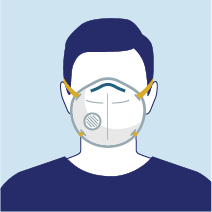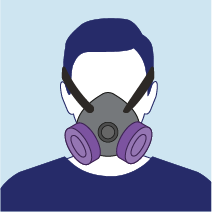Personal Protective Equipment used in Baking
Personal Protective Equipment used in Baking1. Hairnets-
2. Non slip shoes-Non-slip shoes help to reduce slips, trips and falls. The slip-resistant grip on the tread of the shoes helps the wearer stay on their feet when walking on wet and greasy surfaces. Employees who work in food service, catering, health care, construction, manufacturing, and more, benefit from wearing non-slip shoes.
3.. Face mask/Respirator-
Respirators
N95 Respirator
Elastomeric Respirator
- Respirators protect wearers from breathing in hazardous contaminants in the air.
- Respirators are required equipment for workers performing some jobs in the Food and Agriculture Sector.
- If you are required to use a respirator for your job, you should continue to do so.
Disposable Facemasks
- Disposable facemasks, such as surgical or medical masks, are not respirators and do not protect the wearer from breathing in small particles, gases, or chemicals in the air.
- Disposable facemasks act as a protective barrier to prevent splashes, sprays, large droplets, or splatter from entering the wearer’s mouth and nose. The protective quality of disposable facemasks varies depending on type of material used to make the facemask.
- Disposable facemasks also help prevent the wearer from spreading respiratory droplets.
- Because disposable facemasks help prevent the wearer from spreading respiratory droplets, they may slow the spread of the virus that causes COVID-19. Wearing them may help people who unknowingly have the virus from spreading it to others.
Cloth Face Coverings
- Cloth face coverings, whether provided by the employer or brought from home by the worker, are not respirators or disposable facemasks and do not protect the worker wearing them from exposures.
- Cloth face coverings are only intended to help contain the wearer’s respiratory droplets from being spread.
- Used in this way, CDC has recommended cloth face coverings to slow the spread of the virus that causes COVID-19. Wearing them may help people who unknowingly have the virus from spreading it to others.
- Workers can wear a cloth face covering if the employer has determined that a respirator or a disposable facemask is NOT required based on the workplace hazard assessment.
- When it is not practicable for workers to wear a single cloth face covering for the full duration of a work shift, particularly if they become wet, soiled, or otherwise visibly contaminated, a clean cloth face covering (or disposable facemask option) should be used and changed out as needed.
- Review information provided on how to wear and care for cloth face coverings.
4. Apron-
Restaurant Apron can protect an employee’s cloths or uniform from stains. Otherwise, It can also help in order to protect their skin. After all, restaurant apron serves as a barrier to prevent microorganisms to some extent, but especially physical contaminants like hair, dust, and dirt. Ultimately, Restaurant Aprons are to handle food or works in a food preparation area. aprons are a food safety tool like any tool. Generally, wearing an apron is a good practice to make your brand name visible and to reflect a positive image of your company. Choose an apron style which truly reflects your brand name and how the public will perceive your brand. Having a restaurant apron with pocket makes working much more convenient for your employees. They can easily hold cash, pens, notepads, and other items in the apron’s pocket making for a much smoother customer-employee interaction.
5. Oven gloves-
6. Hand gloves- dishwashing gloves, plastic gloves, surgical gloves
These protect the hands from chemicals and stains
7. Towels: white for utensils, green for hands and
red for tables and
counters- These are used to dry utensils, hands and counters.
Sources:
https://blog.sfceurope.com/how-do-non-slip-shoes-work
https://theexportworld.com/blog-different-apron-uses/












Comments
Post a Comment